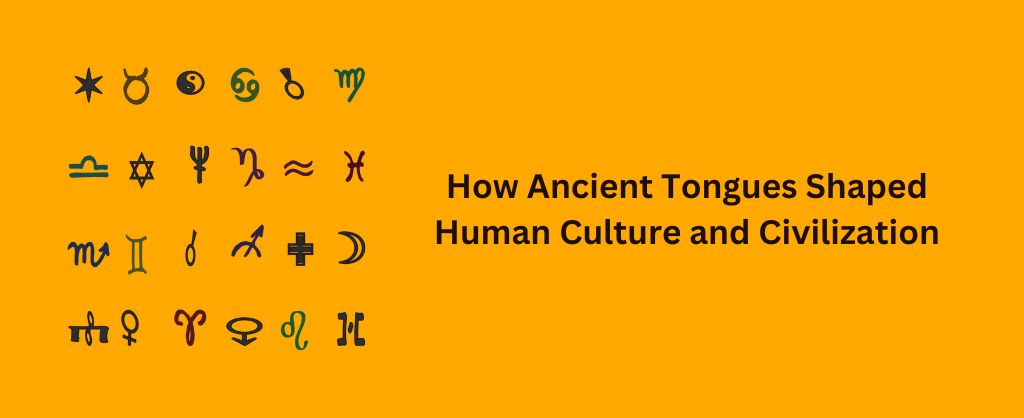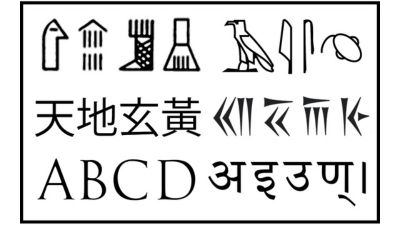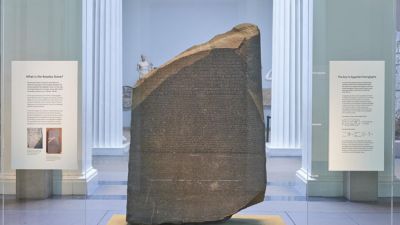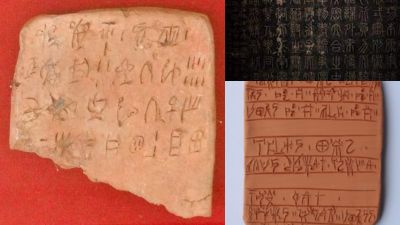Oldest Languages of The World – Evolution of Human Tongues

Language is deeply ingrained in the human experience. The ability to communicate abstract thoughts through a system of sounds, symbols and words allowed us to share ideas, stories and knowledge in incredibly nuanced ways.
But language did not just suddenly appear fully formed; it evolved over a very long period of time alongside human cognitive development.
In this article, we’ll explore what linguists and historians have uncovered about the origins and evolution of language, one of humanity’s most impactful innovations.
You’ll also be able to listen to the sounds of some of the ancient languages later in this article.
Understanding where language came from and how ancient tongues shaped culture gives us profound insights into our ancestors’ lives and knowledge.
The Slow Development of Language in Prehistory
Many of us take language for granted as an innate human ability we’re just born with. But in reality, the development of complex language capabilities reflecting abstract thought was a drawn out process spanning at least hundreds of thousands of years.
Archaeologists and linguists believe language likely emerged progressively in tandem with anatomical changes in early hominin species.
Though the precise details remain cloudy, key developments include:
- Homo erectus: Roughly 1.9 million years ago, these early human ancestors likely produced simple speech sounds and gestures to convey basic meaning. This represented the first baby steps toward spoken language.
- Anatomical changes: Key changes occurred in the vocal tract, larynx and Broca’s area of the brain around 200,000 years ago in early Homo sapiens, allowing for increasingly complex vocalizations and speech sounds.
- Behavioral modernity: Anatomically modern humans developed advanced cognition, abstract thought and multifaceted language around 50,000 years ago. This coincided with creative expression like cave painting, jewelry and bone carvings emerging.
- Writing systems: Spoken language likely existed for hundreds of thousands of years before the development of writing systems like cuneiform around just 5,500 years ago.
Early linguistic capabilities undoubtedly helped early humans share important survival knowledge, coordinate hunting groups and develop cultural traditions that provided community cohesion and ritual practices.
So robust spoken language clearly predates written scripts by a massive timespan.
Candidates for the World’s Oldest Known Languages
While the primordial verbal languages used by early hominins will likely never be known, these examples stand out as some of the oldest recorded:
- Sumerian: This language of ancient Mesopotamia dominated the region from around 3500 BCE to 2000 BCE. Sumerian cuneiform represents the earliest writing found.
- Egyptian: Hieroglyphs etched on monuments and pyramids date back over 5,000 years. Spoken Egyptian gradually developed into Coptic Egyptian which survived until around the 17th century CE.
- Akkadian: Emerging from Sumerian roots around 2500 BCE, Akkadian employed the same cuneiform writing system and remained in use until about 400 BCE.
- Ancient Chinese: Earliest forms of written Chinese date back to Shang Dynasty oracle bones around 1200 BCE, but the origins of spoken Chinese remain mysterious.
- Elamite: The Elamite civilization in modern day Iran used this language written in complex cuneiform from 2800 BCE until the 2nd century BCE.
- Tamil: In southern India, written records in Tamil have been dated back to around 500 BCE, with linguistic roots stretching back thousands of years earlier.
- Semitic languages: This family includes ancient tongues like Akkadian, Hebrew, Arabic and Aramaic originating around 3500 BCE in the Middle East.
While these examples do not encompass the oldest human speech, they provide the earliest written windows available into ancient languages and societies.
Deciphering Lost Languages to Illuminate History
One of the most pivotal events in understanding ancient languages occurred when the Rosetta Stone was finally deciphered in 1822.
The Rosetta Stone, carved around 200 BCE, presented identical passages in both Egyptian hieroglyphs and Ancient Greek.
Through decades of work by scholars like Jean-François Champollion and Thomas Young, the mysterious hieroglyphs were finally translated.
This allowed the secrets of Ancient Egyptian culture and history concealed for centuries to be revealed after hieroglyphic writing fell out of use around the 4th century CE.
The decoding of ancient languages remains challenging but immensely rewarding work. It provides insights into past cultures and societies that could not be achieved otherwise.
Tracing the Evolution of Language Through Language Families
While individual languages constantly evolve and eventually fade away, language families often persist much longer across populations over time.
Understanding these complex language families provides vital clues into ancient human migrations and interactions.
For example:
- The Indo-European family likely spread from the Pontic steppes into Europe and Asia with groups like the Yamnaya around 4000 BCE. It includes Sanskrit, Greek, Latin and all modern European languages.
- The Sino-Tibetan family, which includes Chinese, Burmese and Tibetan among others, originated around 4500 BCE in northern China before expanding southward.
By examining how these language families diversified and spread geographically over thousands of years, researchers can piece together ancestral human movement patterns that left few reliable records.
The Enduring Mysteries of Lost Ancient Languages
For all that researchers have managed to decipher about ancient languages, many extinct tongues remain locked away, resisting interpretation and translation. These mysterious lost languages include:
- Etruscan: The isolate language of the ancient Etruscans in Italy gradually died out after being absorbed by Latin. Only limited texts exist to help decipher it.
- Minoan: The undeciphered Linear A script of the Bronze Age Minoan civilization could reveal insights about their culture if decoded.
- Indus Script: Inscribed artifacts from the Indus Valley civilization contain this undeciphered pictographic script dating back to 2500 BCE.
- Isthmian: Little is known about this native Mesoamerican script that disappeared around 500 CE, with few examples surviving.
- Harappan: Thousands of artifacts bearing undeciphered symbols from the Indus Valley civilization continue to defy translation.
These lost languages hold intriguing secrets, and while progress unlocking them is slow, future archaeological findings may eventually decode these lingering linguistic puzzles.
Watch these videos to listen to the sounds of some of the ancient languages
The Interconnected Evolution of Language and Culture
Looking across the arc of human history, language and culture evolved together in a symbiotic relationship, each shaping the other.
As languages developed increased complexity to reflect abstract thought, they allowed for the transmission of more advanced knowledge and technologies.
At the same time, cultural innovations drove the emergence of new languages and dialects tailored to novel trades, belief systems, scientific disciplines and art forms. It was a feedback loop propelling human societies forward.
For instance, the development of farming and trade in the Fertile Crescent gave rise to lengthy Akkadian words for grains, weights and measures.
In India, ancient Sanskrit evolved with fluid vowels reflecting spiritual chanting traditions. And nautical terms permeated coastal languages like Phoenician.
Language inherently reflects and transmits the values, norms and beliefs of a society. As cultures changed over the millennia, so too did the languages they spoke.
Proto-World and the Origins of Language
Attempting to definitively identify the world’s oldest language remains challenging at best, and perhaps impossible. However, researchers have proposed intriguing theories about the possible origins of language in humanity’s ancestral past:
- Gestural theory: Early hominins like Neanderthals may have begun developing language through hand gestures and pantomimes. This may have laid the groundwork for advanced communication.
- Proto-World theory: A hypothesized proto-language, or “mother tongue” stemming from Africa, may have eventually diverged into all modern language families.
- Multi-regional theory: Different language families could have independently emerged in geographic regions as human brains evolved distinct capacities for advanced communication.
- Prelingual communication: Anatomical adaptations like the larynx descended to enable complex vocalizations, upon which spoken languages later built.
While the exact roots remain obscure, it’s clear language did not emerge instantly, but rather incrementally across eons, an adaptive trait interwoven with human biology and culture.
The Languages That Made Humans Human
Human language represents a pinnacle of evolutionary development. The ability to relay intricate information between individuals and across generations created a communal repository of knowledge and history that shaped humanity.
Language gave us the stories, beliefs, and ideas that form the bedrock of culture. It allowed technology and knowledge to accumulate over centuries in what we call civilization.
Language connected smaller bands into larger cooperative societies by enabling common customs and norms.
Some scholars believe advanced language and abstract thought were the decisive advantages that allowed Homo sapiens to thrive where other hominins could not.
Though we may never trace all the steps back to the earliest glimmerings of human speech, it is clear language was foundational to humanity’s successes.
Recent studies even suggest sophisticated language emerged much earlier than expected – more than 170,000 years ago rather than 50,000 years ago based on abstractions in shell bead jewelry craftsmanship.
This illustrates how our understanding of language origins continues evolving today.
Unlocking the Secrets of the Past
Despite huge advances made in historical linguistics, much work remains unraveling humanity’s linguistic heritage. We may never fully trace language back to its ultimate genesis.
But the examples of languages preserved from antiquity, however fragmentary, still resonate across the ages.
Through ancient languages, modern society connects to past peoples, cultures, and ways of life distant in time, but still meaningful and insightful even millennia later.
When we translate an Egyptian poem, decipher an ancient codex or speak words in a reconstructed proto-language, we bridge eras in the human story.
There are few scholarly pursuits that are more profoundly human than the quest to recover lost languages and reconnect to voices from humanity’s dawn. Their words remind us that while civilizations come and go, human hopes, fears and ideas endure.
Understanding where we’ve been informs where we are going – and language lights that path. Our linguistic past whispers still within us, guiding us ever forward.
Humanity’s gift for language is ultimately part of what makes us who we are. Exploring its origins provides unique insight into human nature and what connects us across all barriers of time and culture.
Language gives us the power to communicate, share ideas, build civilizations, and envision a better future together.












